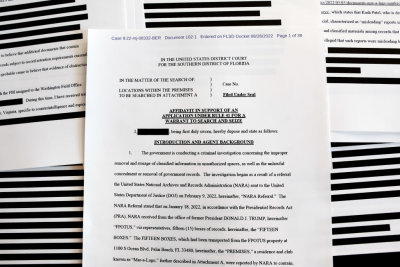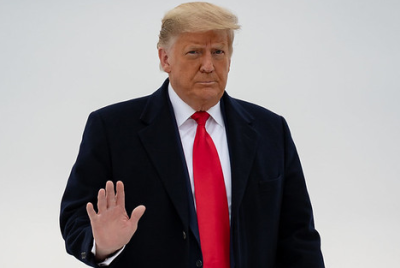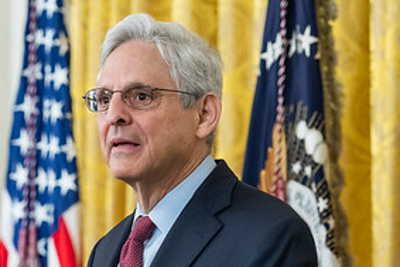Timeline of FBI Investigation of Trump’s Handling of Highly Classified Documents
The FBI on Aug. 8 executed a search warrant at former President Donald Trump’s Mar-a-Lago property in Florida. A federal judge magistrate signed the warrant after “finding probable cause that evidence of multiple federal crimes would be found” at Trump’s property.
A property receipt of the items taken from Mar-a-Lago listed 11 sets of classified records, including four sets labeled “Miscellaneous Top Secret Documents” and one marked as “Various classified/TS/SCI documents,” which stands for “Top Secret/Sensitive Compartmented Information.”
That’s in addition to 184 classified documents totaling more than 700 pages that Trump voluntarily provided to the National Archives and Records Administration nearly seven months earlier on Jan. 18.
 Redacted affidavit in support of a warrant to search Mar-a-Lago. Photo Illustration by Mario Tama/Getty Images.
Redacted affidavit in support of a warrant to search Mar-a-Lago. Photo Illustration by Mario Tama/Getty Images.
A heavily redacted affidavit filed by the Justice Department in support of the search warrant revealed that 92 of those 184 classified documents were marked as “secret” and 25 were marked as “top secret,” including classified national intelligence further marked to protect the control and dissemination of intelligence sources, methods and activities.
The partial redacted search warrant for Mar-a-Lago revealed that Trump is under investigation for potentially violating any of three criminal codes involving the mishandling of classified information.
The Justice Department investigation is still in the early stages and more information undoubtedly will come out. For now, we provide a timeline of events, which we will update as warranted.
2021
Jan. 18 — With two days remaining in Trump’s presidency, boxes containing documents are moved from the White House to Mar-a-Lago.
May 6 — The National Archives makes a request for missing presidential records “and continued to make requests until approximately late December 2021 when NARA was informed twelve boxes were found and ready for retrieval” at Mar-a-Lago, according to the Department of Justice’s affidavit requesting a warrant to search Mar-a-Lago.
December — NARA begins to arrange for the documents to be securely transported from Mar-a-Lago to Washington.
2022
Jan. 18 — NARA receives 15 boxes of records from Trump that had been taken to Mar-a-Lago, including “highly classified documents intermingled with other records,” according to DOJ’s affidavit.
 Former President Donald Trump
Former President Donald Trump
Jan. 31 — NARA issues a statement that says some of the records it retrieved from Mar-a-Lago “included paper records that had been torn up by former President Trump.” NARA adds, “As has been reported in the press since 2018, White House records management officials during the Trump Administration recovered and taped together some of the torn-up records.”
Feb. 7 — NARA issues a statement confirming that it had received 15 boxes of records from Mar-a-Lago in mid-January. “Former President Trump’s representatives have informed NARA that they are continuing to search for additional Presidential records that belong to the National Archives,” the statement says.
Feb. 8 — NARA issues a statement that says: “Throughout the course of the last year, NARA obtained the cooperation of Trump representatives to locate Presidential records that had not been transferred to the National Archives at the end of the Trump administration. When a representative informed NARA in December 2021 that they had located some records, NARA arranged for them to be securely transported to Washington. NARA officials did not visit or ‘raid’ the Mar-a-Lago property.”
Feb. 9 — The special agent in charge of NARA’s Office of the Inspector General refers the matter to the Department of Justice, according to DOJ’s affidavit.
Feb. 18 — The archivist of the United States sends a letter to the House Oversight Committee that says: “NARA has identified items marked as classified national security information” in the materials recovered from Mar-a-Lago. As a result, “NARA staff has been in communication with the Department of Justice.”
Trump issues a statement that says, “The National Archives did not ‘find’ anything, they were given, upon request, Presidential Records in an ordinary and routine process to ensure the preservation of my legacy and in accordance with the Presidential Records Act.”
April 11 — At the Department of Justice’s request, the White House Counsel’s Office formally transmits a letter asking that “NARA provide the FBI access to the 15 boxes” taken from Mar-a-Lago.
April 12 — NARA notifies Trump’s lawyer that it intends to provide FBI access to the 15 boxes of documents taken from Mar-a-Lago in January.
April 29 — The Department of Justice’s National Security Division sends a letter to Evan Corcoran, an attorney for Trump, that says access to documents taken from Mar-a-Lago is “necessary for purposes of our ongoing criminal investigation.”
“According to NARA, among the materials in the boxes are over 100 documents with classification markings, comprising more than 700 pages,” the letter says. “Some include the highest levels of classification, including Special Access Program (SAP) materials.”
The DOJ tells Corcoran it needs access to the documents to assess “the potential damage resulting from the apparent manner in which these materials were stored and transported.”
That same day, Corcoran writes to NARA, seeking to delay the FBI review of the documents taken from Mar-a-Lago. Corcoran argues that Trump needs time “to ascertain whether any specific document is subject to [executive] privilege” and have the opportunity “to assert a claim of constitutionally based privilege.”
May 1 — Corcoran again asks NARA to delay the FBI review.
May 10 — In response to Corcoran’s request for a delay, Debra Steidel Wall, acting archivist of the United States, sends a letter to Corcoran, saying that she “decided not to honor the former President’s ‘protective’ claim of privilege,” and to allow the FBI review to begin as soon as May 12.
“The question [of executive privilege] in this case is not a close one,” Wall writes. “The [current] Executive Branch here is seeking access to records belonging to, and in the custody of, the Federal Government itself, not only in order to investigate whether those records were handled in an unlawful manner but also, as the National Security Division explained, to ‘conduct an assessment of the potential damage resulting from the apparent manner in which these materials were stored and transported and take any necessary remedial steps.’” (The letter was first published Aug. 23 on a website owned by journalist John Solomon, who was designated by Trump to serve as his liaison to NARA.)
May 11 — Trump’s office receives a subpoena seeking additional documents marked as classified. (The subpoena is disclosed in a motion filed by Trump on Aug. 22.)
May 16-18 — FBI agents review the 15 boxes retrieved from Mar-a-Lago. They identify “184 unique documents bearing classification markings, including 67 documents marked as CONFIDENTIAL, 92 documents marked as SECRET, and 25 documents marked as TOP SECRET,” according to the DOJ affidavit.
May 25 — Corcoran, Trump’s lawyer, sends the Justice Department a letter that asserts, among other things, that Trump, as president, had “Absolute Authority To Declassify” government documents, according to DOJ’s affidavit.
June 3 — Jay Bratt, chief of the counterintelligence and export control section in the DOJ’s National Security Division, visits Mar-a-Lago and inspects a storage room on the property, according to a motion filed by Trump’s attorney on Aug. 22.
June 8 — Five days after Bratt’s visit, the Justice Department sends Trump’s lawyer a letter saying Mar-a-Lago is not “authorized for the storage of classified information.” The DOJ asks that Trump’s office preserve the documents and secure the room where the documents are stored, according to the DOJ affidavit.
June 19 — Trump designates two new representatives to NARA: John Solomon, a journalist, and Kash Patel, a former top defense aide during the Trump administration.
June 22 — The DOJ sends a subpoena to Trump’s office “seeking footage from surveillance cameras at Mar-a-Lago,” according to the Aug. 22 Trump motion.
Aug. 5 — A federal magistrate judge in Florida, Bruce Reinhart, signs a search warrant for Mar-a-Lago “after finding probable cause that evidence of multiple federal crimes would be found at the Premises,” according to the judge’s order to unseal the affidavit.
Aug. 8 — The FBI executes the search warrant at Mar-a-Lago. The search lasts nine hours and results in the recovery of more classified documents.
 U.S. Attorney General Merrick Garland
U.S. Attorney General Merrick Garland
Aug. 11 — U.S. Attorney General Merrick Garland confirms the search of the former president’s residence, saying he “personally approved” the request for a search warrant. “Upholding the rule of law means applying the law evenly, without fear or favor. Under my watch, that is precisely what the Justice Department is doing,” he says.
Garland also announces that the Department of Justice filed a motion to unseal the warrant and a copy of an inventory of seized items.
Aug. 12 — The U.S. Southern District Court of Florida releases partially redacted versions of the search warrant and property receipt for items collected at Mar-a-Lago.
The property receipt shows that the FBI seized three sets of records labeled either “Confidential Document” or “Miscellaneous Confidential Documents,” three sets labeled “Miscellaneous Secret Documents,” and four sets labeled “Miscellaneous Top Secret Documents.” One set was listed as “Various classified/TS/SCI documents,” which stands for “Top Secret/Sensitive Compartmented Information.”
“Top secret” is the highest level of classification because the classified information, if released, could cause “exceptionally grave damage to the national security,” as the National Archives explains on its website.
The search warrant reveals that Trump is under investigation for potentially violating any of these three criminal codes:
Section 2071 of Title 18 of the U.S. Code, which relates to someone who “willfully and unlawfully conceals, removes, mutilates, obliterates, falsifies, or destroys” a government record.
Section 1519 of Title 18, which relates to someone who “knowingly alters, destroys, mutilates, conceals, covers up, falsifies, or makes a false entry in any record, document, or tangible object with the intent to impede, obstruct, or influence the investigation or proper administration of any matter within the jurisdiction of any department or agency of the United States.”
Section 793 of Title 18, which is part of the Espionage Act and deals with “gathering, transmitting or losing defense information.”
Solomon, one of Trump’s representatives for interacting with NARA, appears on Fox News and reads a statement from Trump’s office that says Trump, as president, had a “standing order” to declassify all documents taken to Mar-a-Lago.
Notably, however, all three laws cited in the warrant apply to the mishandling of government records regardless of classification. (For more, read “Trump’s Dubious ‘Standing Order’ to Declassify Documents.”)
Aug. 22 — Lindsey Halligan, an attorney representing Trump, files a “Motion for Judicial Oversight and Additional Relief.” The motion requests that the court appoint a special master to review the documents collected from Mar-a-Lago during the execution of the search warrant and prevent further FBI review until a special master is appointed. It also asks that the Justice Department provide “a more detailed” receipt of the documents seized during the search and return any seized items that aren’t in the scope of the search warrant.
Aug. 26 — The Justice Department releases a heavily redacted copy of the affidavit that it filed with the court in Florida to obtain the search warrant. The affidavit states that “probable cause exists” to believe that classified national defense information records were “improperly” moved to Mar-a-Lago and stored in “unauthorized spaces.” It says, “There is also probable cause to believe that evidence of obstruction will be found at the PREMISES.”
The affidavit says the FBI’s preliminary review found 14 of the 15 boxes that Trump provided to NARA in mid-January contained classified information. At that time, the FBI identified “184 unique documents bearing classification markings, including 67 documents marked as CONFIDENTIAL, 92 documents marked as SECRET, and 25 documents marked as TOP SECRET. Further, the FBI agents observed markings reflecting the following compartments/dissemination controls: HCS, FISA, ORCON, NOFORN, and SI,” which places controls on access to especially sensitive information.
“Controls on the dissemination and use of classified national intelligence are necessary to protect intelligence sources, methods, and activities,” according to the National Security Agency’s classification manual. The NSA manual says:
The HCS marking “protects the most sensitive” information gathered from “clandestine and/or uniquely sensitive” human sources.
The FISA marking indicates the material was gathered under the Foreign Intelligence Surveillance Act, which allows for court-approved electronic surveillance and physical searches of “a foreign power or an agent of a foreign power.”
ORCON is short for “originator control,” which means that anyone seeking to disseminate information marked as ORCON must get “advance permission” from the originator of the document.
NOFORN means the information is “not releasable to foreign nationals.”
SI, or special intelligence, “protects technical and intelligence information derived from the monitoring of foreign communications signals.”
Aug. 27 — U.S. District Judge Aileen M. Cannon in Florida issues a preliminary order that indicates her “preliminary intent to appoint a special master” and schedules a Sept. 1 hearing on Trump’s motion.
Aug. 29 — The DOJ notifies Cannon that its Privilege Review Team completed its review of the documents taken from Mar-a-Lago for claims of attorney-client or other privileges. It “identified a limited set of materials that potentially contain attorney-client privileged information.”